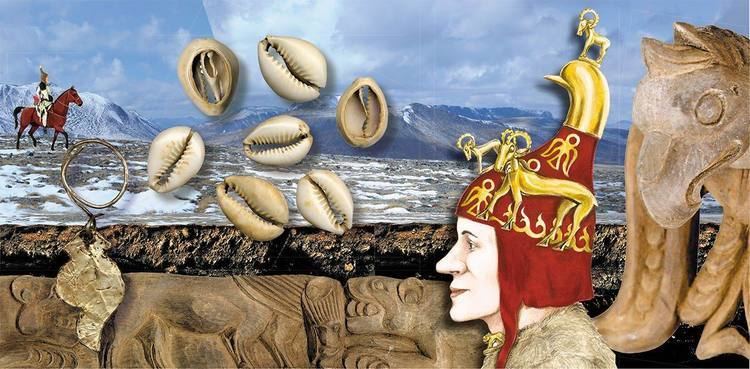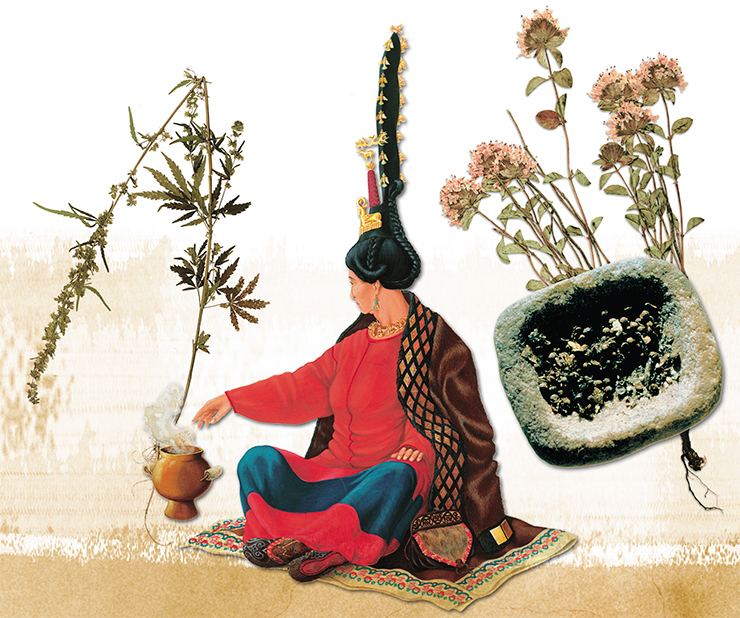 | ||
Pazyryk culture
The Pazyryk culture is a Scythian Iron Age archaeological culture (c. 6th to 3rd centuries BC) identified by excavated artifacts and mummified humans found in the Siberian permafrost, in the Altay Mountains, Kazakhstan and nearby Mongolia. The mummies are buried in long barrows (or kurgans) similar to the tomb mounds of western Scythian culture in modern Ukraine. The type site are the Pazyryk burials of the Ukok Plateau.(NOVA 2007) Many artifacts and human remains have been found at this location, including the Siberian Ice Princess, indicating a flourishing culture at this location that benefited from the many trade routes and caravans of merchants passing through the area.(State Hermitage Museum 2007) The Pazyryk are considered to have had a war-like life.(Jordana 2009)

Other kurgan cemeteries associated with the culture include those of Bashadar, Tuekta, Ulandryk, Polosmak and Berel. There are so far no known sites of settlements associated with the burials, suggesting a purely nomadic lifestyle.

Because of a freak climatic freeze, some of the Altaic burials, notably those of the 5th century bc at Pazyryk and neighbouring sites, such as Katanda, Shibe, and Tuekt, were isolated from external climatic variations by a protective layer of ice that conserved the organic substances buried in them. At Pazyryk these included the bodies of horses and an embalmed man whose body was covered with tattoos of Scythian animal motifs. The remarkable textiles recovered from the Pazyryk burials include the oldest woollen knotted-pile carpet known, the oldest embroidered Chinese silk, and two pieces of woven Persian fabric (State Hermitage Museum, St. Petersburg). Red and ochre predominate in the carpet, the main design of which is of riders, stags, and griffins. Many of the Pazyryk felt hangings, saddlecloths, and cushions were covered with elaborate designs executed in appliqué feltwork, dyed furs, and embroidery. Of exceptional interest are those with animal and human figural compositions, the most notable of which are the repeat design of an investiture scene on a felt hanging and that of a semihuman, semibird creature on another (both in the State Hermitage Museum, St. Petersburg). Clothing, whether of felt, leather, or fur, was also lavishly ornamented.

Horse reins either had animal designs cut out on them or were studded with wooden ones covered in gold foil. Their tail sheaths were ornamented, as were their headpieces and breastpieces. Some horses were provided with leather or felt masks made to resemble animals, with stag antlers or rams’ horns often incorporated in them. Many of the trappings took the form of iron, bronze, and gilt wood animal motifs either applied or suspended from them; and bits had animal-shaped terminal ornaments. Altaic animals frequently display muscles delineated with dot and comma markings, a formal convention that may have derived from appliqué needlework. Although such markings are sometimes included in Assyrian, Achaemenian, and even Urartian animal representations of the ancient Middle East, they seldom appear on those of purely Scythian origin. Roundels containing a dot serve the same purpose on the stag and other animal renderings executed by contemporary Śaka metalworkers. Animal processions of the Assyro-Achaemenian type also appealed to many Central Asian tribesmen and are featured in their arts.
Certain geometric designs and sun symbols, such as the circle and rosette, recur at Pazyryk but are completely outnumbered by animal motifs. Such specifically Scythian features as zoomorphic junctures—i.e., the addition of a part of one animal to the body of another—are rarer in the Altaic region than in southern Russia. The stag and its relatives, however, figure as prominently in Altaic as in Scythian art. Combat scenes between carnivores and herbivores that occur quite often in Scythian art are exceedingly numerous in Pazyryk work; but, whereas the Scythians show the victim passively accepting its fate, as on 5th-century bc gold triangular plaques from the so-called Seven Brothers burial in the Kuban, the Pazyryk beasts are locked in such bitter fights that the victim's hindquarters become inverted.
DNA samples recovered from the remains of two Pazyryk males showed them to be members of Y-chromosome haplogroup N1b-P43.
